Imani Jacqueline Brown, What remains at the end of the earth?, 2022
I have never been a fan of the word ‘timely’ being used in exhibition or book reviews but in the case of the exhibition Dear Earth, which is currently on display at the Hayward Gallery, London, I think an exception must be made.
I went to visit this exhibition a few weeks ago, shortly before the UN declared that the world has moved from the phase of ‘Global warming’ into the phase of ‘Global boiling’. As I looked around the cool galleries in the brutalist building, temperatures around the world soared in excess of 40 degrees and wildfires raged throughout countries in Europe. Having experienced the hottest temperatures ever recorded in the UK in the summer of 2022, the choice to programme a summer exhibition exploring themes of ‘care, hope, and emotional and spiritual connection with our environment’ was a clever one.
Dear Earth brings together 15 artists from around the world and reflects on our emotional connection with nature, as well as the interdependence of ecologies and ecosystems. The considerations of the exhibition even extended to the reception area, where visitors are given a wooden token instead of a printed paper ticket, which is inserted into a box at the entrance and subsequently reused. The usual printed exhibition guides are also clearly absent.
Aluaiy Kaumakan, The Axis of Life & Vines in the Mountain, 2018
For me, one of the most striking works in the exhibition was Aluaiy Kaumakan’s, The Axis of Life & Vines in the Mountain, 2018. This textile sculpture dominates the gallery with its salient reds, oranges, and yellows. Born in Pingtung County, Taiwan, Kaumakan uses ‘Lemikalik’, a Paiwan artistic technique that consists of weaving in concentric circles. Her practice is inspired by her Paiwan culture and tradition. In 2009, a devastating typhoon forced the Indigenous Paiwan community to leave their home in the mountains of southern Taiwan. Kaumakan worked collaboratively with the displaced women in her community, sharing the traditional weaving technique. The Axis of Life & Vines in the Mountain rises to the gallery ceiling, filling the space and stretching out across the gallery floor with its blood-like veins or tendrils. The right of the sculpture is like a great, organic mountain formed of natural fibres and recycled materials. Bright red tendrils stream from the mountain and stretch out across the floor like the roots of a tree, tethering it to the earth. The centre of the sculpture is like a gigantic sun, hot and burning and giving life with its warmth. To the left, a smaller structure rises, almost human like in its upright stance, with a decorative, floral head. Bloodlines stream from this source and tether it to the earth. All is interweaved and interconnected in this intricate sculpture, which is partly inspired by the Paiwan’s highly ornamental ceremonial dress, representing the artist’s idea of the unbreakable bond between people and land, joining people to even the most unstable environments.
Andrea Bowers, Memorial to Arcadia Woodlands Clear-Cut (Green, Violet, and Brown), 2014
Artist and Activist, Andrea Bowers begins her section of the exhibition with a flashing neon which declares Climate Change is Real, the word ‘Real’ flashes on and off in the warning colour red. In comparison to the emergency sign the visitor is first confronted with, a more subtle neon illuminates the opposite wall, a tangle of black and neon green leaves, which highlights the gentler message, ‘Women have always thought like mountains’, in the middle of the sculpture in blue. In the centre of the gallery, a large chandelier like sculpture hangs from the ceiling, lengths of green, yellow, and purple cord support branches of severed wood commemorating a forest in California that ecofeminist Bowers attempted to save by tying herself to an oak tree, alongside fellow activists. The action failed and this work, Memorial to Arcadia Woodlands Clear-Cut (Green, Violet, and Brown), 2014, holds the last of the forest’s scattered wood chippings, following its destruction. Arguably, the most beautiful of Bower’s works are the large coloured drawings from her Eco Grief Extinction Series. Drawn in acrylic marker on cardboard, the bright drawings mourn the loss of Hawaiian flora and fauna recently declared extinct. Entwining grieving women and nature, the drawings all include a quotation of poetry by healer-poet Deena Metzger, reminding us that ‘We are part of nature, not outside of it. What we do to the Earth, we do to ourselves’.
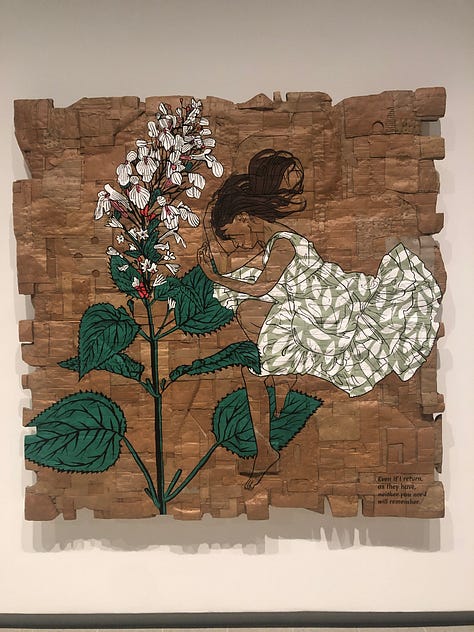
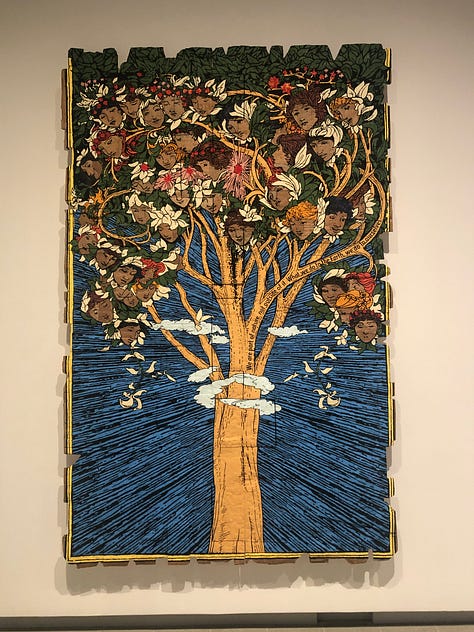
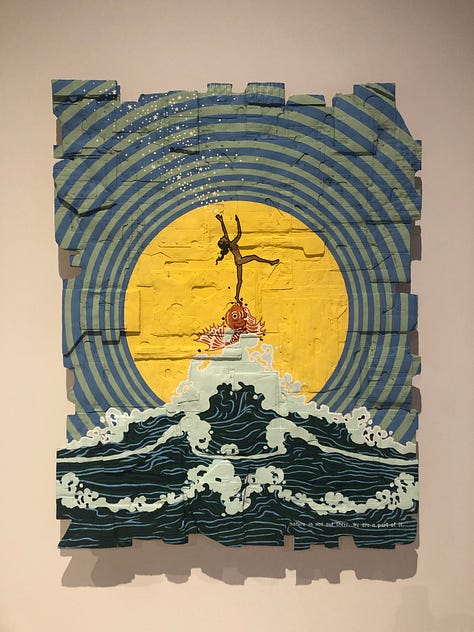
Andrea Bowers, works from Eco Grief Extinction Series
The exhibition is full of work by strong female artists, including Hito Steyerl’s, Green Screen, 2023, which highlights the connection between the climate crisis and the vast carbon footprint caused by the tech world. Steyerl’s monumental LED screen is made from empty bottles and crates, and is powered by a wall of living plants on its reverse. Bioelectrical signals from the plants are converted into sounds and images displayed on the LED wall, presenting everchanging brightly coloured images that look like a cacophony of different coloured flowers continuously blooming to a soundtrack of intriguing tinkles and jingles, like the flowers are speaking a secret language.
Another new commission for the exhibition is Cornelia Parker’s two-channel video, THE FUTURE (Sixes and Sevens), 2023. This hilarious interview with a group of primary school children aged 6 and 7 years old, shows the children answering and pondering questions about what they imagine the future will be. The innocence of the children and their wonderful imaginations, is starkly contrasted with the adults watching, who are the only ones who can make the changes needed for this younger generation to live in a safer and more sustainable world.
Imani Jacqueline Brown explores the ecological crisis in Louisiana, USA. Until I visited this exhibition, I had no idea of the destruction taking place in this area due to petrochemical facilities. Brown traces the violent colonisation of the area, beginning with the conquest of indigenous territory, then the establishment of sugar plantations and slave labour, culminating with the oil and gas industry occupying most of the area today. The video installation, What remains at the end of the earth?, 2022, maps the hidden geographies of wells and canals, which spread like a disease across the country, and juxtaposes this with the locations of enslaved people’s burial grounds where groves of commemorative magnolia trees were planted, a sign of resistance against the destructive petrochemical industry and an active tool of ecological regeneration.
Daiara Tukano, Ohpëkó Pati – world of the sacred waters of the Grand Mother of the Universe, 2023 & Pirõ nïkï. Forest of the Serpent, 2023.
My favourite works were by Daiara Tukano who created two new large-scale paintings especially for the exhibition. For me, these were the highlight of the entire show. The artist believes her works are a way of listening to the world around us, rather than a way of sharing messages. Tukano belongs to the Yépá Mahsã people, (widely known as Tukano). The paintings are inspired by Hori, dreams and ‘cosmo-visions’ triggered by consuming the plant-based medicine with psychedelic effects, called ‘Kaphi’. The paintings, like Hori, attempt to depict an experience which lies beyond human perception. These paintings are the artist’s tribute to the forests which once covered Europe.
Agnes Denes, The Living Pyramid, 2015/2023
Other works include the most exquisite drawings by Agnes Denes, who uses scientific methods and techniques to produce abstract representations of the natural world. These leads to Denes’ huge installation, The Living Pyramid, 2015/23, an enormous, iconic pyramid full of plants, whose point reaches to the ceiling. The pyramid is surrounded by photographs of Denes’ other outdoor works, including her well-known Wheatfield – A Confrontation, 1982, intervention in New York.
Artist and Environmental Activist, Jenny Kendler’s sculptures on the outside sculpture terrace, Birds Watching III, 2023, consist of brightly coloured birds’ eyes from one hundred species of threatened birds, dramatically reminding the visitor that nature is watching us and witnessing our destructive actions. Alongside this is Tell it to the Birds, 2014-23, in which visitors whisper a secret into a moss and steel enclosed microphone, which is then translated and broadcasted in bird song.
Jenny Kendler, Birds Watching III, 2023
Himali Singh Soin’s, two-channel video, we are opposite like that, 2019, uses performance, poetry, textile, video, and sculpture to imagine new mythologies for the Antarctic and Arctic poles. Cristina Iglesias’ immersive environment, Pabellón de Cristal I, 2014, consists of a green glass room with a metal grid floor, which reveals water flowing over a rocky surface beneath, disorienting the visitor and alluding to the natural earth underground, hidden beneath our feet. Ackroyd & Harvey’s portraits of activists and collective members are portrayed through photographic photosynthesis works grown from grass seed.
Richard Mosse, Grid (Palimu-ú), 2023, (video still)
Richard Mosse’s striking photographs showing the effects of oil extraction by multinational companies on Kichwa Indigenous Territory in north-eastern Peru, lead the way to his presentation of Grid (Palimu-ú), 2023, videos of a series of empowering but sorrowful speeches by the Yanomami people recorded in the village of Palimu-ú, near the Brazil-Venezuela border. To the left of this video presentation, is a grid of screens, which display an ever-changing sequence of bird’s eye view photographs of sites of environmental crimes in the rainforest. The leaders of the local villages, filmed by Mosse on analogue 35mm infrared film, give forceful and moving speeches about the state of their homes and ancestral land, and the destruction to their livelihood caused by illegal mining. The people are fierce with their hate and disapproval, and demand that Western leaders help to end their suffering, they demand the army come and remove the illegal miners, they demand the return of health care to their area, and they call for assistance in creating sustainable projects they can work on to support themselves. The leaders tell how their food sources have been destroyed, animals no longer inhabit the rainforest near their villages, fish in the river are polluted. Parents must watch their sick children suffer. The speeches are heart-breaking, and the silence of the visitors watching show their impact. Interestingly, every leader demands that they are not recorded merely for the sake of spectacle (my words…), but that their testimonies are used as evidence to solicit real action from the rest of the world. The work certainly packs a punch to its audience but I was disappointed to note that there is no documentation detailing how the artist is using this work, or how he plans to use this work, to respect their wishes and utilise this documentation for real action, and to help them improve their situation.
Otobong Nkanga, Double Plot, 2018
The exhibition begins with the work of Otobong Nkanga, and the entire premise for the show takes its cue from a quote of Nkanga’s, ‘care is a form of resistance’. In the centre of the gallery stands the new installation, The Trifurcation, 2023, a large, naturally fallen sweet chestnut tree, its roots interwoven with rope, which lead to three glass biospheres, each a new mini ecosystem, generating new life. Behind this work is the huge tapestry, Double Plot, 2018. The background of the great, dark tapestry is an image of the Milky Way, captured in 2011 during the uprising in Tahrir Square, Cairo. Networks of lines and divisions suggest land barriers, tension, and restriction, and interconnected circles, like bold, red planets, show photographic images of explosions and riots, all held on a connecting rope by a headless person standing next to a tree. The galaxy is vast, but Nkanga shows it is fractured, divided, and controlled, much like our planet. Works from Nkanga’s series In Pursuit of Bling, are also displayed. Responding to the destructive extraction of natural resources from the Earth, Nkanga’s drawings, photographs, and video, demonstrate the history of violence done to the people and the land in Africa, and tells stories about the consumption of natural resources, and the connections between body, land, and mineral.
Dear Earth is a thought-provoking exhibition which guides the visitor through a series of intimate works focussing on each artist’s personal acts of activism, drawing awareness to small corners of the world and just some of its struggles. Themes of interconnectedness and interdependence run throughout the works, highlighting everyone’s part in the climate crisis, and also how everyone needs to be part of the solution. The exhibition does fail to answer if these artists are helping to make positive, physical changes with their work, but overall, I believe Dear Earth is a beautifully told love letter to a damaged and fractured world.
Dear Earth is on display at the Hayward Gallery, London, UK until 3 September 2023.
All photographs are my own.




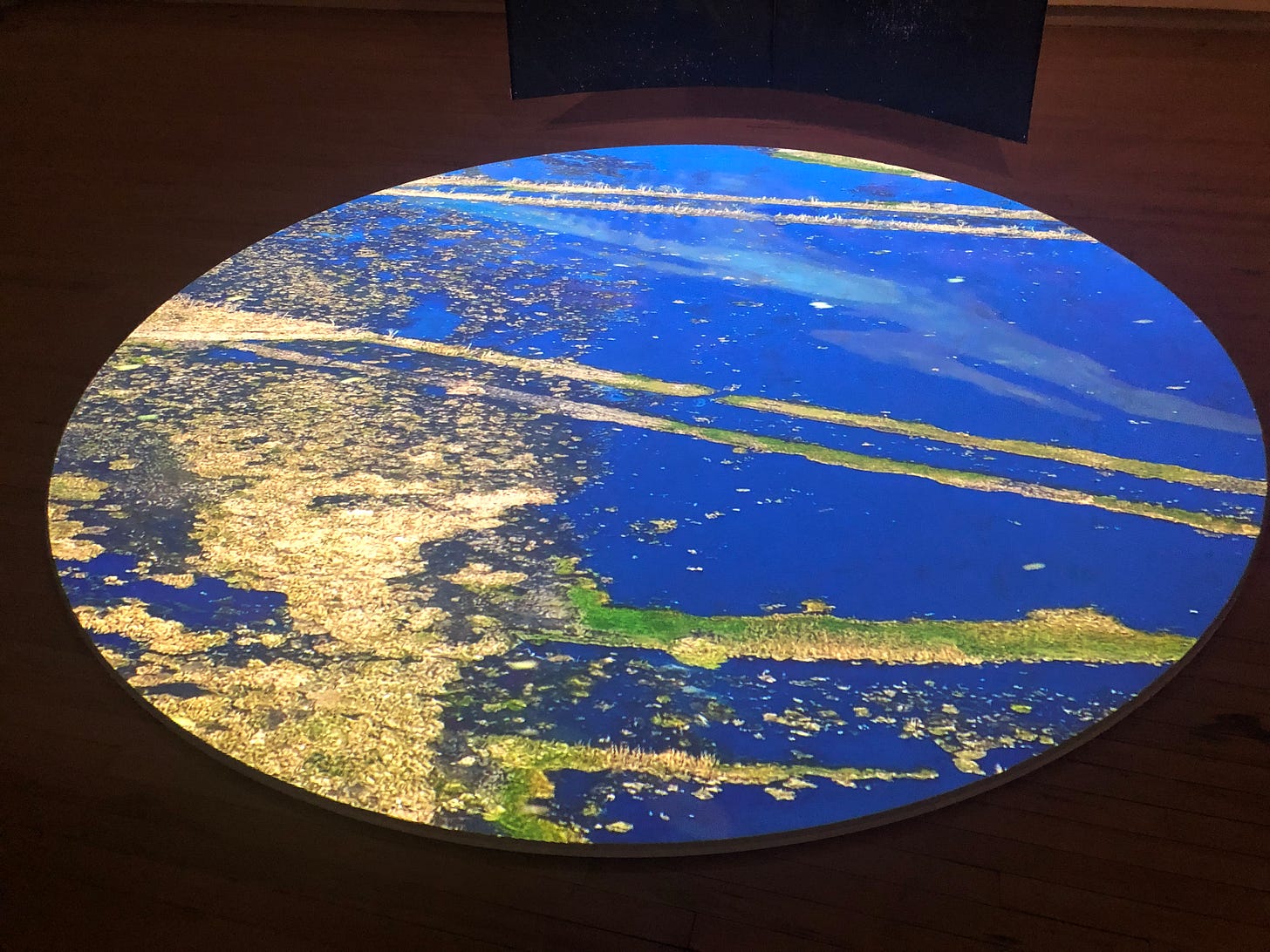
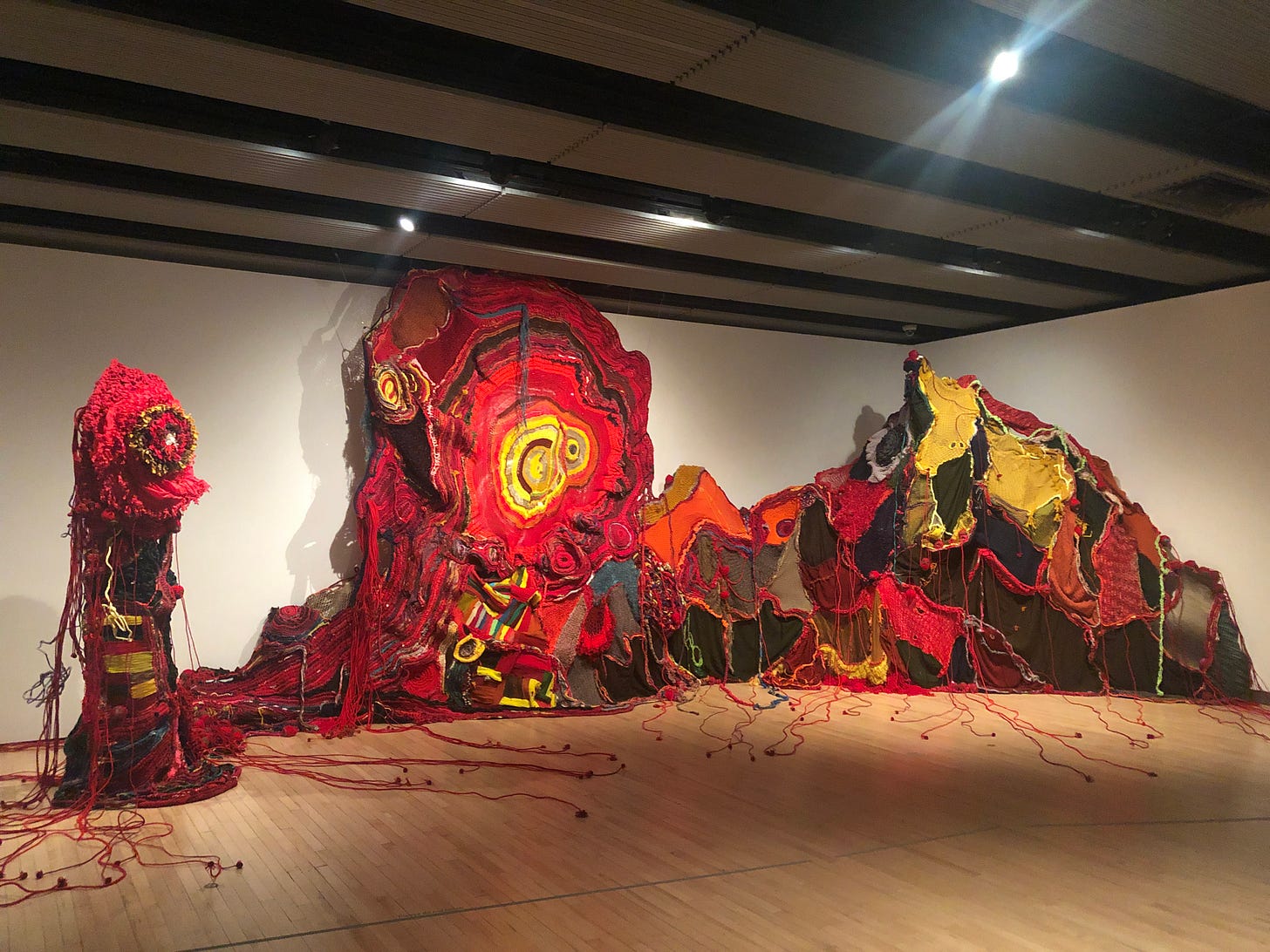
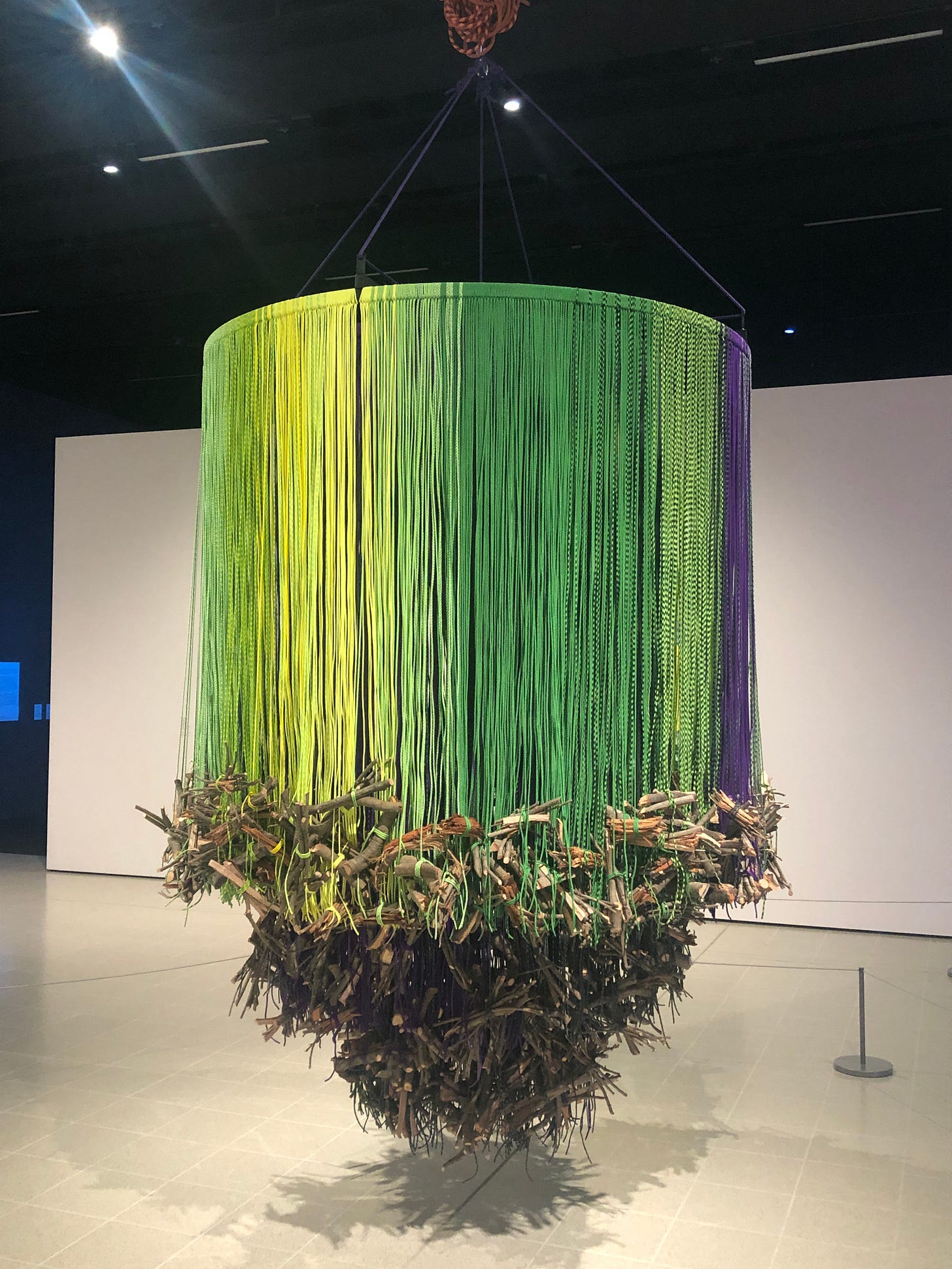
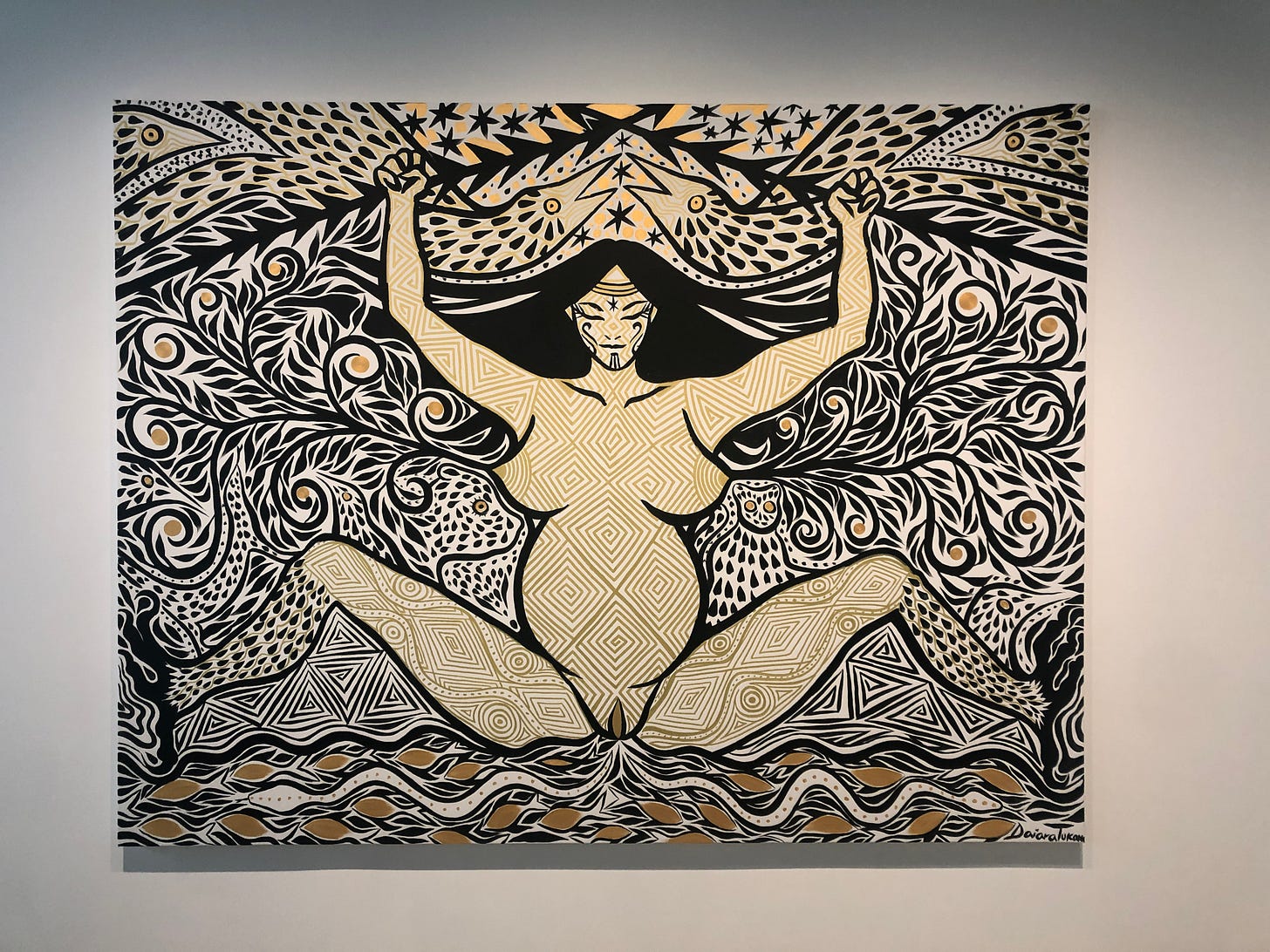

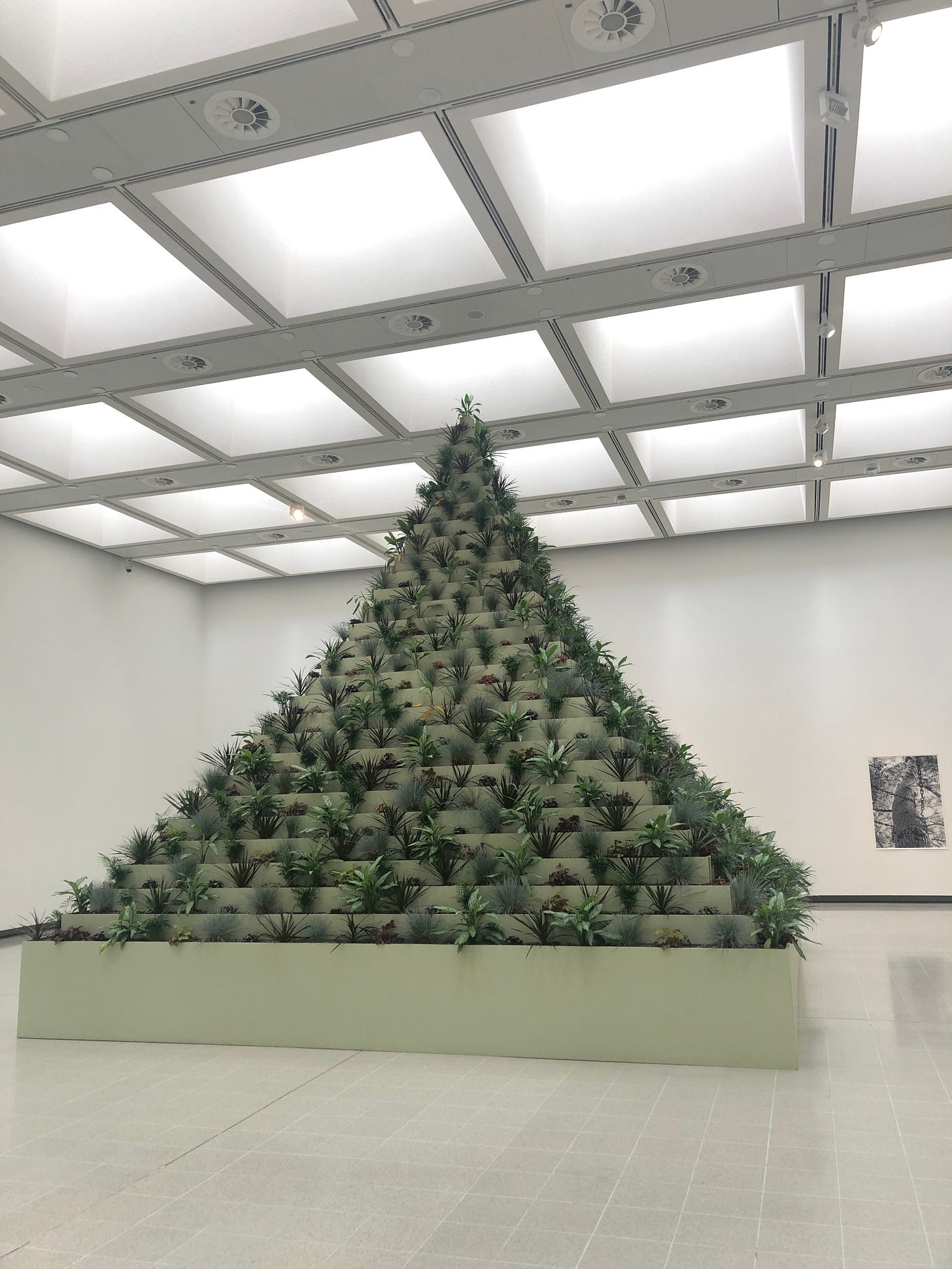

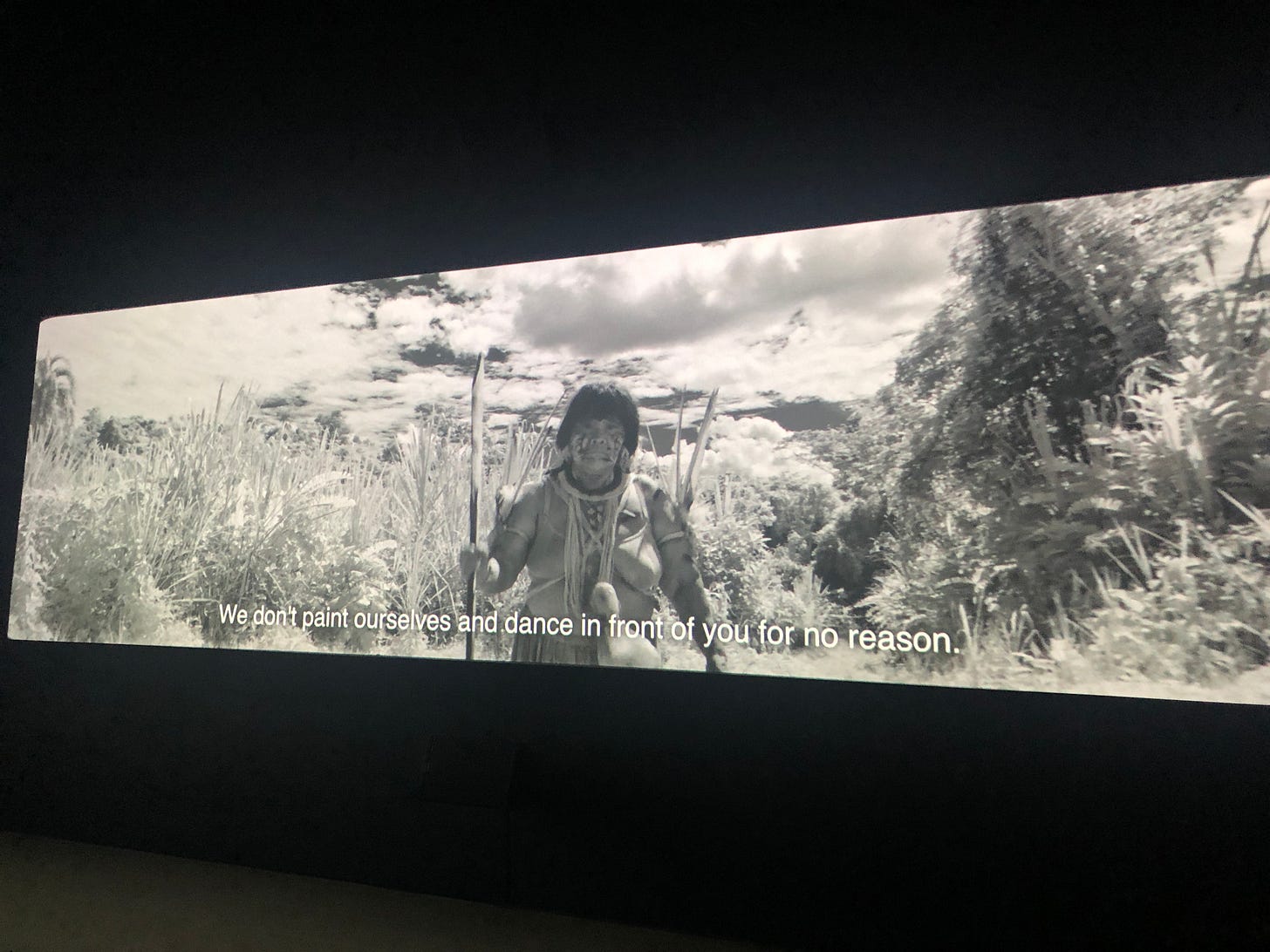
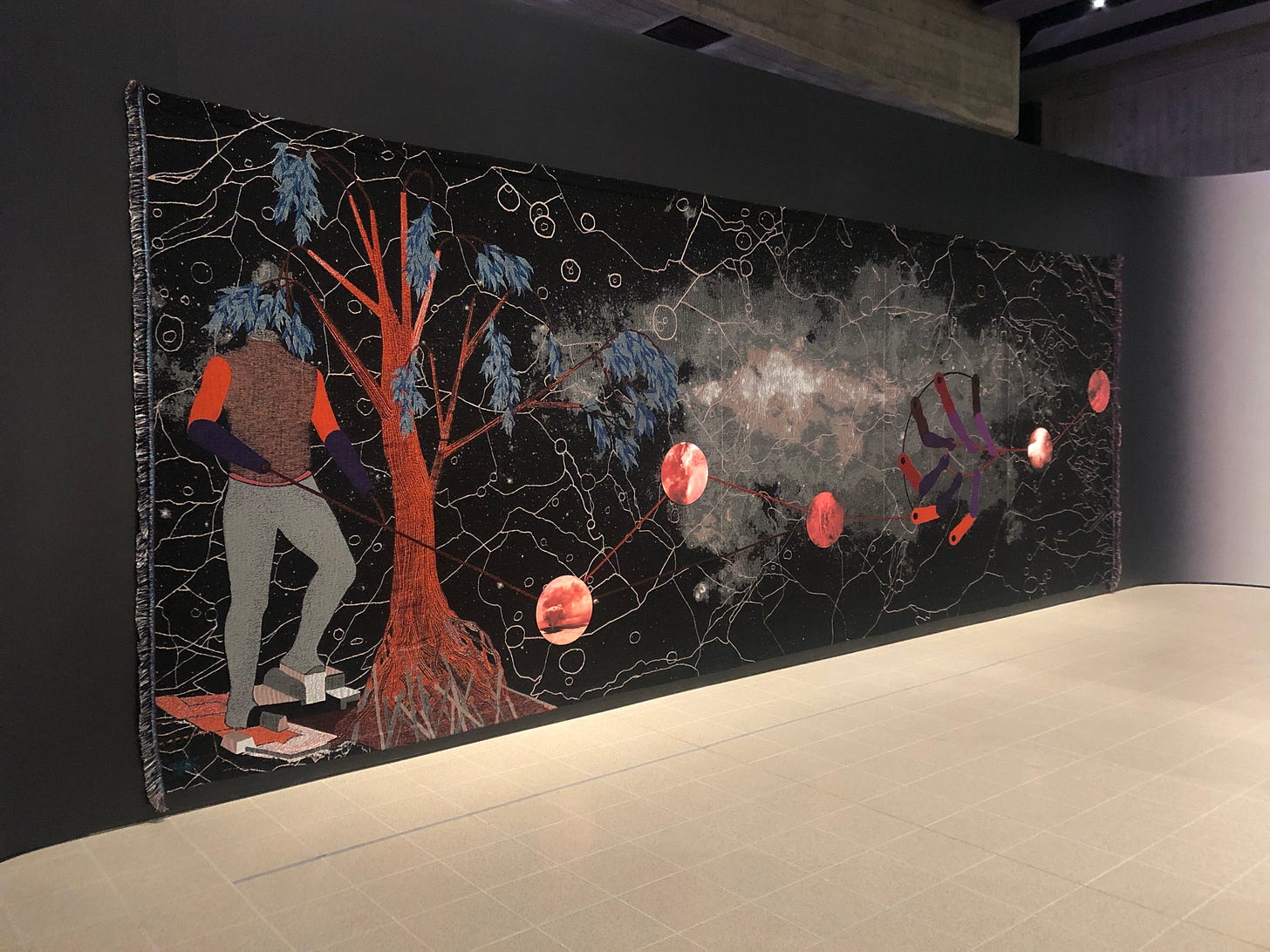
Such an important exhibit, here in these days Climate Crisis. Thanks for these photos showing the amazing artists in this exhibit at Hayward Gallery.
So much beauty in this essay and so timely, considering that too many on the political MAGA right in the US declare that global warming is, to quote, "a hoax". Please check your yahoo email as I'm so looking forward to your post on https://innerlifecollaborative.substack.com -- I need you to click the "accept" in the email from our settings as your Friday date approaches. Hope the email didn't go into your spam, Luisa: worth checking there for one from me and one from out settings. xo ~ Mary